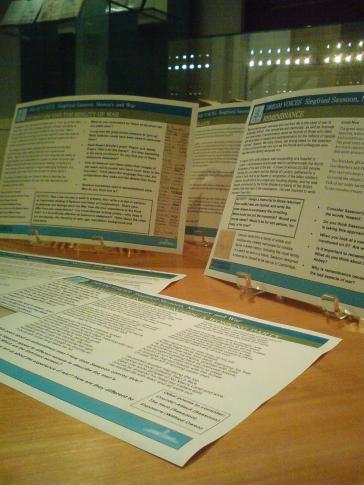With much of the ground work now done I am beginning to write detailed descriptions of the collection. There is a quantity of correspondence in which I am expecting to find the identification of authors by their scrawled signatures somewhat trying. Since we hold a number of other collections containing correpondence to Sassoon here at the Cambridge University Library I decided to improve my chances of deciphering some of the signatures by converting an existing catalogue to one such collection into a format that I could add to our cataloguing database. I am pleased to announce that this work is now complete and I have loaded the resulting descriptions onto the Janus website where you are welcome to browse through them along with other catalogues to archives held throughout Cambridge:
Link to the catalogue of MS Add.8889 on the Janus website
The content of the letters is rather varied as they are drawn from a variety of sources including items which Sassoon either placed or left enclosed in the volumes of his personal library. My particular favourite is a letter from Lady Ottoline Morrell ”enquiring the time of his arrival and asking him to bring a horse” (MS Add.8889/2/5).
Anyone with a Cambridge University Library reader’s card validated for the Manuscripts Reading Room may consult the letters. Information on how to apply for reader status is online on the Library’s Admissions pages.
One of the disadvantages of reading for pleasure rather than for research is there is (in me at least) a tendency for the choice of books to be fairly discursive. Consequently, when something interesting crops up it’s often difficult to spot that it might one day prove useful in another context and ought to be carefully noted down for future reference. And after a while, of course, I can no longer remember where on earth I read it.
During the time I’ve been working on Sassoon I’ve been trying to recall where I once saw (or heard – maybe it was on television or radio) the story of an old Army officer from the Great War who had been reading an anthology of the war poets. He had fought on the Western Front and spent a lot of time in the trenches. He wasn’t a literary man. He was asked what he thought of the poems of Sassoon, Owen and their contemporaries, and replied that yes, they were jolly good, very descriptive and realistic. Then he paused and added: ‘But those poet chaps – they do seem to have made rather heavy weather of it all!’
I’d very much like to pin this down. Can anyone point me to a reliable source for it?
A ‘guest post’ by Hannah Haines of the Library’s Entrance Hall staff.

The 'Dream Voices' teaching resource in the Exhibition Centre
The history and literature of the Great War has been a topic on the GCSE syllabus for many years, and from the outset of planning the ‘Dream Voices’ exhibition, we were aware of the potential for involving local schools in the Sassoon project. Making the subject of conflict accessible to the 13–16 age group presents challenges, but by inviting pupils to engage with original historical sources, we hope to show how archival research can inspire lively insights into material they may have only seen printed in textbooks.
In order to maximise the appeal of an exhibition visit to teachers, we have put together a resource pack that highlights particular items from the collection and suggests discussion points to tie the visit to the curriculum requirements. We identified key themes that would be relevant to studies in English Literature, History and Citizenship, such as depictions of trench warfare, Sassoon’s anti-War protest of 1917, and the concepts of patriotism and remembrance. Although the process of writing the pack began before the exhibition was assembled, some of Sassoon’s best-known works presented themselves as suitable source material. There was an amount of adjustment to be done once the CD of exhibition images arrived (my first, excited, viewing of the archive!) – for instance, Sassoon’s sketch of a memorial statue to be erected in Cambridge adds a great visual element to discussions of how people can be encouraged to remember and commemorate war.
These packs have been dispatched to a number of teachers, and we hope that the result will be a number of small group visits in the Michaelmas Term that will take in the exhibition and suggested follow-up activities.
